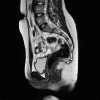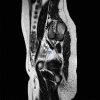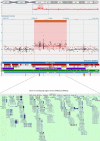Mayer-Rokitansky-Küster-Hauser syndrome with 22q11.21 microduplication: a case report
- PMID: 33883018
- PMCID: PMC8058992
- DOI: 10.1186/s13256-021-02716-6
Mayer-Rokitansky-Küster-Hauser syndrome with 22q11.21 microduplication: a case report
Abstract
Background: Mayer-Rokitansky-Küster-Hauser (MRKH) syndrome (Online Mendelian Inheritance in Man [OMIM] #277000) is a congenital condition characterized by the total or partial agenesis of vagina and uterus. Agenesis can be isolated (MRKH 1) or associated with other renal, vertebral or cardiac defects (MRKH 2).
Case presentation: In this paper, we report a case of a Caucasian patient showing the clinical signs associated with MRKH. Array-based comparative genomic hybridization (a-CGH) analysis revealed a microduplication of approximately 3.01 megabases (Mb) located on the long arm of chromosome 22 (22q11.21). Microduplications affecting the 22q11.21 region have been shown to be associated with MRKH syndrome and Müllerian aplasia. The phenotype of patients with 22q11.2 duplication (OMIM #608363) appears extremely variable, ranging from apparently normal to mild learning difficulties or with multiple defects, sharing features with DiGeorge/velocardiofacial (DGS/VCFS) syndrome.
Conclusions: The altered gene expression together with other genetic, nongenetic, epigenetic or environmental factors can cause the extremely variable phenotype in patients carrying such duplication. Therefore, we can consider MRKH syndrome to be one of the clinical features of DGS/VCFS syndrome.
Keywords: 22q11.2 microduplication; Mayer-Rokitansky-Küster-Hauser syndrome; Multiple congenital anomalies; Müllerian anomalies.
Conflict of interest statement
The authors declare that they have no competing interests.
Figures




References
-
- Cheroki C, Krepischi-Santos AC, Rosenberg C, Jehee FS, Mingroni-Netto RC, Pavanello Filho I, Zanforlin Filho S, Kim CA, Bagnoli VR, Mendonça BB, Szuhai K, Otto PA. Report of a del22q11 in a patient with Mayer-Rokitansky-Küster-Hauser (MRKH) anomaly and exclusion of WNT-4, RAR-gamma, and RXR-alpha as major genes determining MRKH anomaly in a study of 25 affected women. Am J Med Genet A. 2006;140(12):1339–1342. doi: 10.1002/ajmg.a.31254. - DOI - PubMed
Publication types
MeSH terms
Supplementary concepts
LinkOut - more resources
Full Text Sources
Other Literature Sources
Medical
Miscellaneous

